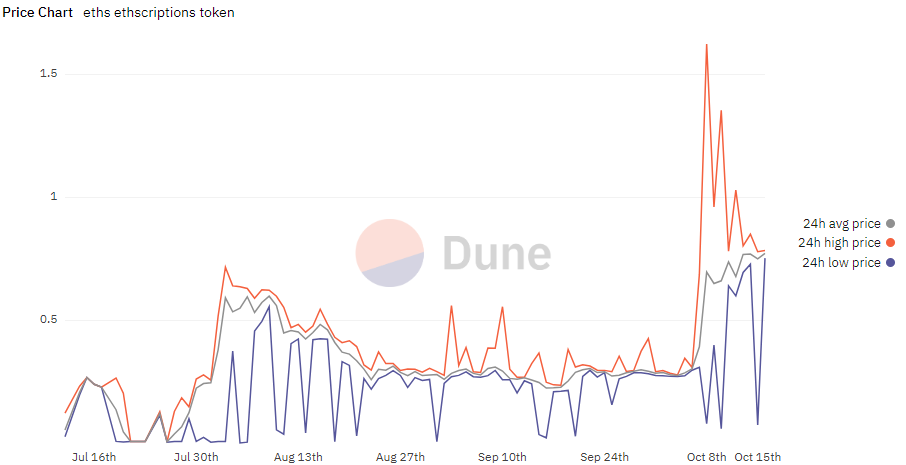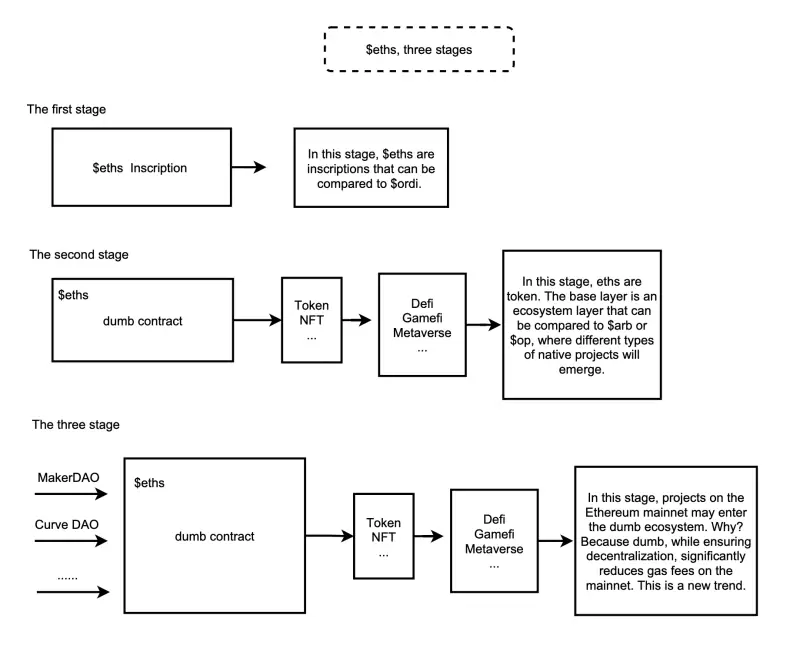L2 New Narrative? An Article to Help You Understand Ethereum Inscriptions
Source of Heat
On June 17, the Ethereum inscription protocol Ethscriptions was launched, with the minting cost of its text token $eths being around 0.5 U. Within a few days after the minting ended, the off-market price reached 100 U, bringing a hundredfold return to early participants, and by early August, the price skyrocketed to 500 U. However, as the price of $ordi continued to decline, the popularity of $eths gradually faded, and the price fell back to around 300 U. After more than two months of silence, on October 8, $eths experienced an explosion, with the price climbing to 800 U, igniting the FOMO sentiment of those who missed out.

In the official Telegram group, community members stood by at all times, commenting and retweeting under tweets related to $eths to increase traffic and promote the dissemination of related tweets. At the same time, KOLs regarded $eths as a traffic password, publishing various content related to $eths, and even casually mentioning $eths could attract huge interaction. Under the promotion and discussion of community members and some KOLs, many previous onlookers who had not participated in Ethscriptions also joined the grand discussion. However, this was merely behavior dictated by interest and cannot serve as a basis for our investment decisions.
Concept of Ethereum Inscriptions
The Ethereum inscription protocol Ethscriptions is similar to the Ordinals protocol on Bitcoin, allowing people to engrave different types of files on the Ethereum mainnet, as long as the size does not exceed 96 KB. Specifically, the protocol allows for the annotation of information (hexadecimal characters) on a transaction, and since the transaction occurs on-chain, it is a completely on-chain action, with characteristics such as immutability and shared ETH security.
The concept of Ethscriptions was proposed by Tom Lehman, co-founder and former CEO of Genius.com, who developed a search engine and website for the protocol on June 17, 2023.

Tom's original intention was to lower the minting cost of NFTs through the Ethscriptions protocol, thereby reducing the financial threshold required for minting NFTs and further promoting the popularization of NFTs. Subsequently, Tom Lehman and his team utilized the calldata field in ETH transactions to store unique reference identifiers, developing a smart contract protocol based on ETH inscriptions to achieve low transaction fees and fast functionality.
Development History
On June 17, Ethscriptions was established, and the first project officially launched was Ethereumpunks, which sold out about 2 hours after going live, currently with a secondary floor price of 0.006 E. Although Ethereumpunks was the first project launched by the official team, the market response was not strong. What truly brought Ethereum inscriptions into the spotlight was the impressive returns of $eths.
On July 17, the trading market Ethscriptions.com was hacked, resulting in a large number of listed inscriptions being stolen. In this attack, approximately 123 addresses lost a total of about 202 inscriptions. Previously, $eths had already experienced a surge, with some inscriptions' prices once reaching 5 ETH. This vulnerability can be traced back to a smart contract created by two co-founders, which contained a small piece of code that allowed people to withdraw inscriptions from the market that did not belong to them. However, this incident was subsequently resolved, and the founders stated that they had contacted many users affected by the vulnerability.
On July 25, founder Tom Lehman tweeted to announce the official launch of Ethscriptions Marketplace V2, introducing a new protocol for the Ethereum subscription market, ESIP-2. The launch of the new market reignited trading enthusiasm for Ethereum inscriptions. OpenSea data shows that as of now, the total trading volume of Ethereum inscriptions has reached 655 ETH.
On August 8, the ESC VM (Ethscriptions Virtual Machine) testnet went live, taking Ethscriptions onto a new development trajectory. In the ESIP-4 proposal, Ethereum inscriptions introduced a virtual machine. This is a new protocol built on top of Ethscriptions. The ESC VM grants Ethscriptions computational capabilities. Additionally, Ethscriptions introduced a contract system known as "Dumb Contracts," allowing users to interact with inscriptions.
On September 8, Ethscriptions officially announced $eths as their official token, allowing inscription tokens to be split through the Dumb Contract bridge. $eths would become the pioneer token of the official bridge for Ethscriptions, with plans to launch a Dumb Contract DEX based on UniswapV2. The introduction of token splitability and the alignment of the Dumb Contract token standard with ERC-20 improved transaction convenience and lowered transaction barriers.
On September 27, the DEX DumbSwap based on Dumb Contracts went live on the testnet.
On the evening of October 8, the price and volume of $eths surged from around 300 U to 800 U, sparking widespread discussion.

On October 9, Ethscriptions completed the ESIP-5 upgrade, reducing transfer gas fees to around 0.05 U, with gas fees lower than some L2 solutions.
The three phases of Ethscriptions development:
Phase One: In this phase, $eths can be compared with $ordi;
Phase Two: In this phase, $eths is a token. The base layer can be compared with Arbitrum or Optimism, and different types of native projects will emerge;
Phase Three: In this phase, projects on the Ethereum mainnet will expand into the ecosystem of Dumb Contracts.

Scaling Implementation Principles
The source of the new narrative for L2 is the development proposals ESIP-5 and ESIP-6 of Ethscriptions.
The ESIP-5 proposal refers to Bulk Ethscription Transfers from EOAs (bulk transfers of inscriptions from EOAs). Currently, non-contract addresses only support the transfer of a single inscription in one transaction. After the launch of ESIP-5, bulk transfers of inscriptions will be supported in a single transaction. ESIP-5 elevates EOAs to the level of smart contracts by introducing a bulk transfer mechanism. According to co-founder @0xHirsch's tweet, each transaction can transfer up to 4,000 inscriptions, costing only 0.11 ETH at the current gas fees.
The ESIP-6 proposal refers to Opt-in Ethscription Non-uniqueness (opt-in non-uniqueness of inscriptions). Currently, only the first inscription with the same content (characters) is considered valid. This indexing rule ensures the uniqueness and distinctiveness of inscriptions but poses limitations and issues for use cases that require the transmission of repeated information, such as smart contracts. For example, the operation of the Ethscriptions virtual machine requires the exchange and verification of information between smart contracts and Dumb Contracts.
The core of Ethscriptions is the ESC VM, which can be compared to the EVM (Ethereum Virtual Machine).
The Dumb Contracts in the ESC VM allow Ethscriptions to break free from the limitations of inscriptions as NFT speculation, entering the realm of functionality and practicality, and officially competing with base layer and L2 solutions.
The ESC VM provides a runtime environment for Dumb Contracts similar to the EVM. Dumb Contracts can execute two commands: deploy (create a new contract) and call (invoke state change functions of existing contracts). The interaction of such contracts is a relatively special form of interaction. Because they are stored through inscriptions, they bypass the execution and storage costs of the EVM (transactions are stored on-chain using the calldata field). This also allows Dumb Contracts to incur costs far lower than those of smart contracts.
Limitations
- The functions of Dumb Contracts cannot be called directly; if you want to send ETH through a Dumb Contract, you must go through a bridge-like process.
(1) Users send ETH to Smart Contracts.
(2) The smart contract creates an Ethscription, sends a call to the Dumb Contract, notifying it that the Smart Contracts have received ETH.
(3) The Dumb Contract verifies whether the Smart Contract is on the trusted Smart Contracts list and then sends the assets to the user.
Limitations of openness and generality. Ethscriptions does not allow arbitrary creation of Dumb Contracts and lacks programmability. Its code is defined along with other Ethscriptions Protocol rules in the ESIP process. Dumb Contracts have fewer functions compared to normal smart contracts and can currently only implement some basic functionalities, such as Deploy, Swap, etc.
Inability to address some complex needs. Although both Ethscriptions and L2 aim to solve Ethereum's scalability and cost issues, simpler needs with established rules are more suitable for resolution through Ethscriptions. L2 solutions offer better openness and generality, with larger capacity and more dimensionality.
Conclusion
Although the price surge and the community's active promotion have generated significant attention, based on the current implemented technology, Ethscriptions, due to its limitations in openness and programmability, cannot directly replace the position of L2, as it can only implement some simple instructions and cannot meet the needs of some developers, posing a considerable challenge for ecosystem construction. However, Ethscriptions is still in its early development stage and has great potential for growth.
The future development of Ethscriptions remains highly uncertain and requires continuous updates and improvements from developers, with two key points to focus on:
Whether existing limitations can be optimized or resolved;
Whether the establishment of the ecosystem can attract users.
The low gas feature of Ethscriptions is similar to L2, and it will be a good traffic tilt point when the L2 track is launched. Currently, L2 projects have already been technically implemented and infrastructure built, while Ethscriptions is still in the planning and design phase, lacking a time advantage. Using L2 as a promotional point is more about capturing traffic. At this moment, Ethscriptions is like a blank slate, and with capital favor and subsequent imagination, along with the technical advantages of ETH, it is not impossible for it to become the beginning of a new track.
Related Information
- Ethscriptions minting and secondary trading market: https://www.etch.market/tokens
- Ethscriptions official Twitter: https://twitter.com/eths_official
- Ethscriptions community Telegram group: https://t.me/ethscriptionsglobal
- Dune dashboard: https://dune.com/etchmarket/ethscriptions-marketplaces








